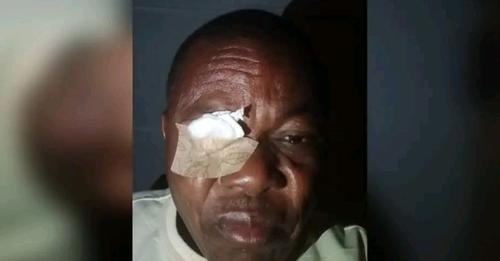
SALE UMAR v. THE STATE
CITATION: (2020) LPELR-51372 (CA)
In the Court of Appeal
In the Gombe Judicial Division
Holden at Gombe
ON WEDNESDAY, 11TH NOVEMBER, 2020
Suit No: CA/G/5CA/2020
Before Their Lordships:
JUMMAI HANNATU SANKEY Justice, Court of Appeal
UZO IFEYINWA NDUKWE-ANYANWU Justice, Court of Appeal
JAMES GAMBO ABUNDAGA Justice, Court of Appeal
Between
SALE UMAR – Appellant =
And
THE STATE – Respondent
LEADING JUDGMENT DELIVERED BY UZO IFEYINWA NDUKWE-ANYANWU, J.C.A.
FACTS
On or about July 3, 2014, about five men armed with guns and sticks robbed a couple of their personal belongings. The couple was robbed of about N350, 000, their Toyota Corolla, cell phones et al. During investigations, five men were arrested and charged before the High Court of Gombe State with various offences including conspiracy and armed robbery. At the end of the trial, the Appellant and others were found guilty of the crimes and sentenced to death.
The Appellant, dissatisfied with the judgment of the High Court of Gombe State filed this appeal.
Issues for determination
The Appellant articulated 3 issues for determination as follows: i. Whether from the evidence before the trial Court, the Respondent had proved its case beyond reasonable doubt as held by the learned trial judge? ii. Whether the trial Court was not wrong by relying on conjectures and the confessional statements, of the Appellant’s co-accused in convicting and sentencing the Appellant for the offence of conspiracy and armed robbery?
iii. Whether or not the trial Court rightly applied and relied on Section 167 of the Evidence Act 2011 in convicting the Appellant.
The Respondent also articulated 2 issues for determination as follows: i. Whether from the totality of evidence adduced before the trial Court, the Respondent had proved its case beyond reasonable doubt against the Appellant for the offences of criminal conspiracy and armed robbery contrary to Section 5(b) and 1(2)(a) of the Robbery and Firearms (special provision) Act 1990 (as amended). ii. Whether the trial Court rightly applied the provisions of Section 167 A of the Evidence Act 2011 (as amended) in convicting the appellant.
Appellant’s submissions
On issue one, Appellant’s counsel relying on SENKANMI ADEBESUN V. THE STATE (2014) LPELR 22694 and Section 135 of the Evidence Act (2011) stated that there must be credible evidence linking the Appellant with the crime. Counsel argued that in criminal cases, the prosecution has the burden of establishing the guilt of the Appellant by proving the essential elements of the charge relying on BELLO v. C.O.P. (2018) 2 NWLR Pt 1603 pg 327.
The Appellant’s Counsel contended that the identity of the Appellant was in issue and the Prosecution failed to conduct an identification parade for Pw1 and Pw2 to identify the Appellant. Counsel argued that neither the Pw1 nor the Pw2 described the Appellant to the police like they did in Court. This description counsel argued should have been given to the police at the earliest opportunity. He relied on ABDULLAHI v. STATE (2008) 17 NWLR Pt 1115 pg 203. Counsel contended that there were contradictions in the evidence of Pw1 and Pw2. Counsel cited OGOGOVIE v THE STATE (2016) LRCLR 4050.
On issue two, the Appellant’s counsel relying on CAJETHAN OKORO Vs THE STATE (20128) LPELR 44273 stated that the Appellant did not admit knowing any of the co-accused and did not admit to participating in the alleged robbery. On issue three, the Appellant’s Counsel argued that the Appellant gave evidence as to how he came about the vehicle found in his possession.
Respondent’s submissions
On issue one from the respondent issues, counsel relying on the cases of ODUNEYE v. STATE (2001) 83 LRCN pg 1, DABOH vs STATE (1977) SSC 222 submitted that an offence of criminal conspiracy can be committed where persons have acted either by agreement or in concert, that mere agreement to commit an offence is sufficient. Counsel mentioned that conspiracy is rarely ever proved by direct evidence, it is invariably an offence that is deduced from the act of the parties thereto, which are focused towards the realization of their common or mutual criminal purpose. He cited SULE v. THE STATE (2009) 7 LRCNCC pg 1.
Counsel submitted that armed robbery is committed where at the time of the commission of the robbery, the accused is proved to have been armed with firearms or offensive weapons. He relied on ONYENYE vs THE STATE (2012) vol 212 LRCN pg 107 where the Supreme Court held that the Prosecution had the burden of proving beyond reasonable doubt in accordance with Section 138 of the Evidence Act. Counsel stated the ingredients of armed robbery which the Prosecution must prove relying on NWATURUOCHA v THE STATE (2011) 9 LRCNCC pg 1, BOZIN v. STATE (1985) 2 NWLR pt 8 pg 465.
Counsel conceded that even though the co-accused made confessional statements implicating the Appellant, such statements are not admissible against the Appellant by virtue of Section 29 of the Evidence Act, 2011. He relied on USMAN v THE STATE (2013) 5 SCNJ 65, AROGUNDARE v THE STATE (2011) 9 LRCNCC 193. Counsel argued that where the PW2 was coming from was immaterial and does not amount to a material contradiction in the testimony of Pw1 and Pw2. He cited OLAYINKA AFOLALU v THE STATE (2012) 10 LRCNCC pg 30.
Counsel stated that identification parade was not obligatory where there is good and cogent evidence linking the Appellant to the crime. That every case must be considered on the evidence adduced and its own particular circumstances. He relied on ALABI v STATE (1993) 13 LRCN pg 977, (1993). Counsel contended that Pw1 positively identified or observed the Appellant well during the robbery and needed no identification parade to pick him out.
Counsel stated that the Appellant’s counsel made heavy weather that the Prosecution did not call the vigilantes who arrested the Appellant to testify, to this end, Respondent’s counsel stated that there was no obligation to call a host of witnesses, that the Prosecution has a right to call the number of witnesses needed to prove its case.
On issue two of the Respondent’s issues, counsel cited Section 167 of the Evidence Act 2011 (as amended) and submitted that the doctrine of recent possession can be applied in this case. Counsel stated the ingredients required to be proved according to Section 167 of the Evidence Act, 2011. Counsel cited STATE v OKONKWO (1988) ILRCNCC pg 33, SALAMI v. STATE (1988) 3 NWLR pt 85 pg 671.
Counsel submitted that the extra-judicial statement and testimony of the Appellant in Court are contradictory as there was no credible explanation on how he was in possession of the stolen car so soon after the robbery. Counsel relying on MADAGWA v. STATE (1988) 5 NWLR pt 92 pg 60 stated that law presumes he is either the thief or the receiver of the car knowing it to be stolen.
Resolution of the issues
The Court stated that the Courts tackle the offence of conspiracy as a matter of inference to be deduced from certain criminal acts or inactions of the parties concerned. The Court cited the case of ODUNEYE v. THE STATE (2001) 13 WRN pg 88.
The Court stated that the bottom line of the offence of conspiracy is the meeting of the minds of the conspirators and that it is a matter of inference from certain acts of the parties. The Court cited NWOSU v. STATE (2004) 15 NWLR pt 877 pg 466, DABOH v STATE (1977) pg 5. The Court stated that in a conspiracy proceeding, evidence of what one accused says in the absence of the other conspirators is admissible against such others, which is an exception to the rule of hearsay. NWOSU v STATE (Supra).
The Court opined that when two or more persons form a common intention to prosecute an unlawful purpose in conjunction with one another, and in the prosecution of such purpose, an offence is committed and each of them is deemed to have committed the offence. The Court relied on MUONWEM vs QUEEN (1963) 2 SC NLR pg 172, OFOR vs QUEEN (1955) 15 WACA pg 4.
The Court mentioned that the Appellant was placed at the scene of the robbery as Pw1 identified him positively. That the Appellant was also seen so soon thereafter, the day after the robbery with the stolen car. The Court opined that the Appellant was one of the conspirators.
On the issue of proving the offence beyond reasonable doubt, the Court stated that the Prosecution proved that the Appellant was one of the robbers who robbed Pw1 and Pw2. That the Appellant was arrested the very next day with the stolen car belonging to Pw2. The Court mentioned that the Appellant had switched the car registration number. The Court opined that the act of changing the vehicle number to his own number meant that the Appellant was privy to the fact that the vehicle was a stolen car. The Court mentioned that the plate no of the vehicle of Pw2 GME 812 AA was found in the Appellant’s house with a bag containing documents belonging to Pw2. The Court cited the case of OSAKWE vs QUEEN (1963) LPELR, 15 482.
On the arguments of the Appellant’s counsel that there are contradictions in the Prosecution’s witnesses, the Court stated that it is well settled that where there are material contradictions in the testimonies of the Prosecution witnesses, it will be wrong for a Court to act on such testimonies. The Court relied on OLUWAFAMO ALO v THE STATE (2015) LPELR 24404.
The Court stated that it is not every trifling inconsistency in the evidence of the Prosecution witnesses that is fatal to its case, only when such inconsistencies or contradictions are substantial and fundamental to the main issues in question before the Court and thus necessarily create some doubt in the mind of the trial Court that an accused is entitle to benefit there from. The Court cited THEOPHILUS v. STATE (supra). The Court mentioned that visual identification is one of the best forms of identification in a criminal case relying on NDUKWE v. STATE (2009) 2 SCN pg 223 Per Rhodes-Vivour ISAH v. STATE (2017) LPELR 43472.
The Court stated that in the evidence of the Appellant, the evidence of how he came by the stolen car was not proved by any iota of evidence. The Court stated that in a criminal trial, the onus lies throughout upon the Prosecution to establish the guilt of the Accused beyond reasonable doubt by virtue of Section 138 of the Evidence Act. That the burden does not shift relying on AIGBADION v THE STATE (2000) 4 SC pt 1 pg 1. The Court stated further that after the Prosecution has adduced evidence which shows that the Accused is guilty of the offence charged, the burden of proving that he is innocent shifts to the Accused by virtue of Section 138 (3) 139, 141 and 142 of the Evidence Act and NASIRU v STATE (1999) 2 NWLR pt 589 pg 87.
The Court therefore opined that the Respondent proved that the Appellant is either the thief or the receiver of the stolen goods, the vehicle.
On the Appellant’s contention that identification parade ought to have conducted by the Prosecution, the Court stated that where the Prosecution witness has knowledge of the Accused person, identification parade is not necessary. The Court cited ARCHIBONG v THE STATE (2004) 1 NWLR pt 855 pg 488, IGBI v. State (2000) 2 SC pg 67. The Court relying on EYISI v. THE STATE (2001) 8 WRN pg 1 opined that recognition of an accused may be more reliable than identification parade.
On the Appellant’s argument that the vigilantes that arrested the Appellant with the vehicle were not called to testify, the Court stated that the right of the Prosecution to call witnesses required to prove its case is not a mere privilege but a prerogative that the Prosecution is not bound to call a host of witnesses but enough material witnesses to prove its case and, in so doing it has discretion in the matter. That one credible witness if believed, is enough. The Court relied on THEOPHILUS v. STATE 1 NWLR pt 423 pg 139, NWAEZE v. STATE (1996) 2 NWLR pt 428 pg 1.
In conclusion, the Court held that the Respondent proved its case against the Appellant beyond reasonable doubt.
Held
On the whole, the appeal was dismissed. The judgment of the lower Court was affirmed as well as the conviction and sentencing of the Appellant to death.
Appearances:
A. S. Muazu Esq. -For Appellant(s)
Zainab A. Rasheed (Solicitor General/Permanent
Secretary, Ministry of Justice, Gombe State), with him, Abdulkadir Umar Esq), – For Respondent(s)
Compiled by LawPavilion













